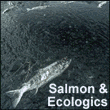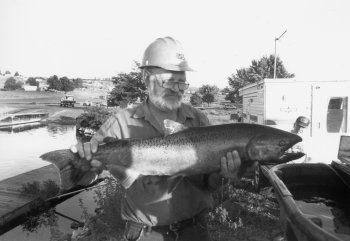forum
library
tutorial
contact

Fall Chinook Mysteries Haunt New BiOp
by Bill RudolphNW Fishletter, September 21, 2004
|
the film forum library tutorial contact |

|
Fall Chinook Mysteries Haunt New BiOpby Bill RudolphNW Fishletter, September 21, 2004 |
Strong hints of more debate over summer spill were in the air at the Sept. 16 meeting of the Implementation Team as mid-level state and federal policy folks were formally introduced to the new draft BiOp developed in the wake of last year's remand process.
The new draft calls for continued summer spill operations at four dams for ESA-listed fall chinook from the Snake River, but also includes language that calls for cost-effective adaptive management, as well as future studies to learn more about the stock and its migration patterns.
The stock at risk, Snake River fall chinook, has been rebounding nicely for the past several years, helped by an infusion of hatchery fish, reduced harvest, safer passage through the hydro system and better ocean conditions. Six thousand fall wilds are expected this year, a far cry from most of the 1990s, when numbers hovered around a thousand at best. NOAA Fisheries had earlier pegged an interim recovery goal of 2,500 fish.
The improving numbers were one reason that action agencies proposed a reduced summer spill regime this year, but the proposal was nixed in federal court, and the expensive summer spill strategy continued, costing BPA $78 million to implement this past July ($40 million) and August ($38 million).
With the fall migration early this year, few listed fish actually benefited from the August spill or barging effort. Information from the Fish Passage Center showed that only 44,000 fall chinook were barged and trucked from lower Snake dams in August, out of nearly 1.6 million fish barged altogether. With only about 10 percent left inriver after passing the collector dams on the Snake, that means about 4,000 fall smolts reached the Columbia River in August.
 In 2003, about twice as many, 82,000, Snake fall fish were barged during August than this year, with nearly 2 million of them barged overall.
In 2003, about twice as many, 82,000, Snake fall fish were barged during August than this year, with nearly 2 million of them barged overall.
In light of the many uncertainties dealing with the stock, both Idaho and Oregon representatives questioned the wisdom of keeping the maximized barging policy in the new draft as both the document's reference operation and proposed operation. NOAA's draft analysis says a 13 percent gap between the hypothetical reference operation that's maxed out for fish survival and proposed operations could be cut in half in five or six years.
Oregon's Ron Boyce questioned the policy of "putting all our eggs in one basket."
Jim Ruff, from NOAA Fisheries' Portland hydropower group, said his agency's scientists have said that no empirical data exists to show whether transportation of the Snake falls is either beneficial or harmful to them.
"The lack of scientific information turned out to be both a science issue to us, in discussions with the Science Center [Seattle], and a policy issue," Ruff said, adding that a policy decision was made "at the management level here" to continue current operations to keep from jeopardizing the good returns in recent years.
"Management was concerned." Ruff said, "that if we made a major change from the way we've been doing things, either it would improve or it would hurt, and they didn't want to take the risk that it would hurt the adult return rate."
The action agencies [BPA, BuRec, COE] have put a high priority on gathering information to answer the years-old question of whether transportation helps the fall run, Ruff said. In the new BiOp, the agencies proposed starting a transport study in 2007 after surface bypass systems are installed at lower Snake dams where the fish are barged.
Boyce said he believed the good returns were more related to good ocean conditions than transportation. But Ruff said the NMFS Science Center thinks a high proportion of returning fall adults spent a year in the hydro system before migrating to sea. Up to now, most biologists have held that most fall chinook migrate to sea after only a few months in the hydro system. Ruff said some research indicates the yearling migrants may come principally from the Clearwater River, where a large effort is underway to develop a fall run from the main lower Snake stock that has evolved in a much warmer ecosystem.
Boyce said he also had questions about how the Washington Department of Fish and Wildlife distinguished sub-yearling from yearling migrants based on scale samples.
Others questioned waiting for the installation of removable spillway weirs before initiating the studies, because it wasn't known whether the passage devices would work for fall chinook. They said a "spread-the-risk" policy should be developed that kept more fish inriver.
"The only thing I'll say," said Ruff, "is our Science Center said, 'you have no information to determine what's the best operation for transportation. We can't tell you what it is. There is little or no empirical information to say whether it works or doesn't work. We can't tell you whether to continue with it, or stop it.'"
Ruff said uncertainties about the life history of yearling fall chinook are substantial. No one knows in which reservoir they spend the winter, or if they go down to the estuary instead. Nor do scientists even have a clue when the yearling fall chinook move downstream. He said action agencies are also proposing studies to get answers to these questions.
In an Aug. 24 memo from the NMFS Science Center posted online with the BiOp earlier this month, federal scientist John Williams said, "we have no data that could provide a basis for meaningful modeling of this important aspect of the complex life cycle of Snake River fall chinook salmon." But Williams did point out that "it appears" about 50 percent of the returning adults migrated to sea as yearlings.
States and tribes have several more weeks to comment on the draft BiOp, which must be completed by Nov. 30, as ordered by federal Judge James Redden.
learn more on topics covered in the film
see the video
read the script
learn the songs
discussion forum
